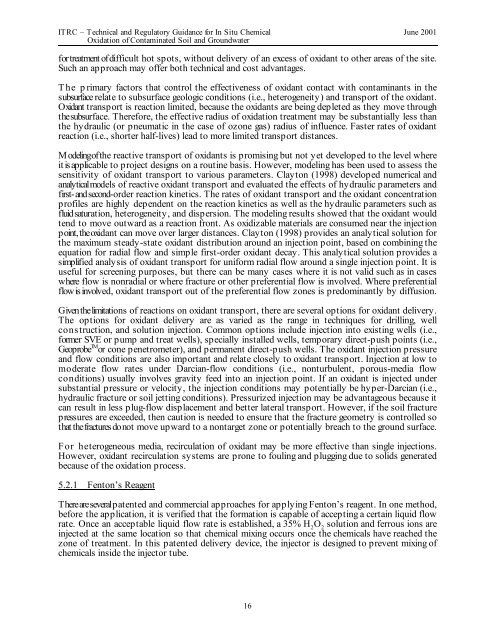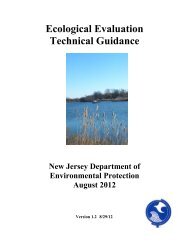Technical and Regulatory Guidance for In Situ Chemical ... - ITRC
Technical and Regulatory Guidance for In Situ Chemical ... - ITRC
Technical and Regulatory Guidance for In Situ Chemical ... - ITRC
Create successful ePaper yourself
Turn your PDF publications into a flip-book with our unique Google optimized e-Paper software.
<strong>ITRC</strong> – <strong>Technical</strong> <strong>and</strong> <strong>Regulatory</strong> <strong>Guidance</strong> <strong>for</strong> <strong>In</strong> <strong>Situ</strong> <strong>Chemical</strong> June 2001<br />
Oxidation of Contaminated Soil <strong>and</strong> Groundwater<br />
<strong>for</strong> treatment of difficult hot spots, without delivery of an excess of oxidant to other areas of the site.<br />
Such an approach may offer both technical <strong>and</strong> cost advantages.<br />
T he p rimary factors that control the effectiveness of oxidant contact with contaminants in the<br />
subsurface relate to subsurface geologic conditions (i.e., heterogeneity) <strong>and</strong> transport of the oxidant.<br />
Oxidant transport is reaction limited, because the oxidants are being depleted as they move through<br />
the subsurface. There<strong>for</strong>e, the effective radius of oxidation treatment may be substantially less than<br />
the hydraulic (or pneumatic in the case of ozone gas) radius of influence. Faster rates of oxidant<br />
reaction (i.e., shorter half-lives) lead to more limited transport distances.<br />
Modeling of the reactive transport of oxidants is promising but not yet developed to the level where<br />
it is applicable to project designs on a routine basis. However, modeling has been used to assess the<br />
sensitivity of oxidant transport to various parameters. Clayton (1998) developed numerical <strong>and</strong><br />
analytical models of reactive oxidant transport <strong>and</strong> evaluated the effects of hydraulic parameters <strong>and</strong><br />
first- <strong>and</strong> second-order reaction kinetics. The rates of oxidant transport <strong>and</strong> the oxidant concentration<br />
profiles are highly dependent on the reaction kinetics as well as the hydraulic parameters such as<br />
fluid saturation, heterogeneity, <strong>and</strong> dispersion. The modeling results showed that the oxidant would<br />
tend to move outward as a reaction front. As oxidizable materials are consumed near the injection<br />
point, the oxidant can move over larger distances. Clayton (1998) provides an analytical solution <strong>for</strong><br />
the maximum steady-state oxidant distribution around an injection point, based on combining the<br />
equation <strong>for</strong> radial flow <strong>and</strong> simple first-order oxidant decay. This analytical solution provides a<br />
simplified analysis of oxidant transport <strong>for</strong> uni<strong>for</strong>m radial flow around a single injection point. It is<br />
useful <strong>for</strong> screening purposes, but there can be many cases where it is not valid such as in cases<br />
where flow is nonradial or where fracture or other preferential flow is involved. Where preferential<br />
flow is involved, oxidant transport out of the preferential flow zones is predominantly by diffusion.<br />
Given the limitations of reactions on oxidant transport, there are several options <strong>for</strong> oxidant delivery.<br />
The options <strong>for</strong> oxidant delivery are as varied as the range in techniques <strong>for</strong> drilling, well<br />
construction, <strong>and</strong> solution injection. Common options include injection into existing wells (i.e.,<br />
<strong>for</strong>mer SVE or pump <strong>and</strong> treat wells), specially installed wells, temporary direct-push points (i.e.,<br />
TM<br />
Geoprobe or cone penetrometer), <strong>and</strong> permanent direct-push wells. The oxidant injection pressure<br />
<strong>and</strong> flow conditions are also important <strong>and</strong> relate closely to oxidant transport. <strong>In</strong>jection at low to<br />
moderate flow rates under Darcian-flow conditions (i.e., nonturbulent, porous-media flow<br />
conditions) usually involves gravity feed into an injection point. If an oxidant is injected under<br />
substantial pressure or velocity, the injection conditions may potentially be hyper-Darcian (i.e.,<br />
hydraulic fracture or soil jetting conditions). Pressurized injection may be advantageous because it<br />
can result in less plug-flow displacement <strong>and</strong> better lateral transport. However, if the soil fracture<br />
pressures are exceeded, then caution is needed to ensure that the fracture geometry is controlled so<br />
that the fractures do not move upward to a nontarget zone or potentially breach to the ground surface.<br />
For heterogeneous media, recirculation of oxidant may be more effective than single injections.<br />
However, oxidant recirculation systems are prone to fouling <strong>and</strong> plugging due to solids generated<br />
because of the oxidation process.<br />
5.2.1 Fenton’s Reagent<br />
There are several patented <strong>and</strong> commercial approaches <strong>for</strong> applying Fenton’s reagent. <strong>In</strong> one method,<br />
be<strong>for</strong>e the application, it is verified that the <strong>for</strong>mation is capable of accepting a certain liquid flow<br />
rate. Once an acceptable liquid flow rate is established, a 35% H2O 2<br />
solution <strong>and</strong> ferrous ions are<br />
injected at the same location so that chemical mixing occurs once the chemicals have reached the<br />
zone of treatment. <strong>In</strong> this patented delivery device, the injector is designed to prevent mixing of<br />
chemicals inside the injector tube.<br />
16
















